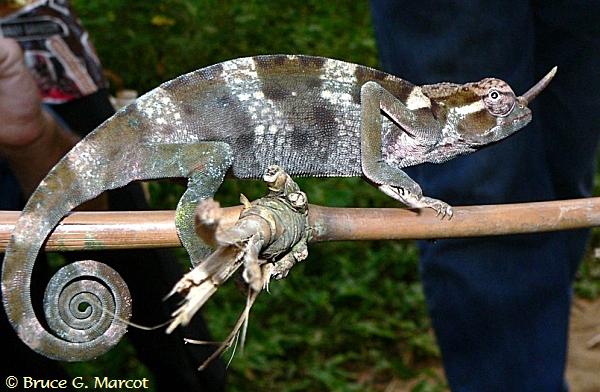
|
The Unicorn Chameleon |
|
|
Click on images for larger versions
|
Owen's Chameleon (Chamaeleo
owenii; prev. C. unicornis), Family Chamaeleonidae |
Credit & Copyright: Dr. Bruce G.
Marcot
|
Explanation: This denizen of hot tropical forests of central Africa is a curiosity in many ways. This is an Owen's chameleon ... but not your typical Owen's chameleon. Owen's chameleons have three horns on their head, but this has only one. Indeed, this form of the Owen's chameleon was once placed in its own species, Chamaeleo unicornis ... the unicorn chameleon.
Think it's easy to sort out situations like this? Consider that there are about 155 species of the genus Chamaeleo alone (although some sources site just 70 species). This is just one. Some species such as Owen's are also placed in the subgenus Trioceros. One source suggests that Chameleo owenii is found only in the lowlands of Cameroon, or just west Africa, but here I have documented its occurrence in the Congo as well. Chameleons also are amazing in other ways. Each eye swivels on its own separate turret, so that they can face in different directions! Image your brain trying to sort that out. But it probably serves well to keep an eye(s) out for predators and for potential prey as well. Their tail is prehensile ... it can wrap around twigs and hold fast. When coiled, it seems to suggest the Fibonacci number series. The toes are spaced into branch-grasping mechanisms ... there are two toes on the outside and three on the inside on the front feet, and three on the outside and two on the inside on the hind feet. This arrangement apparently aids in balancing on branches. I could go on ... the tongue is longer than its body, and is an amazing flexible and sticky organ that shoots out like a slingshot. And
of course they can change body
color and patterns to match their background in camouflage.
I photographed this beautiful specimen in the very remote village of Monkoto that sits between the two main parts of Salonga National Park in central Democratic Republic of the Congo. People of the village were just as amazed by this shy and very uncommon lizard as was I. The
name chameleon
apparently is a Latinized form of the Ancient Greek khamaileon, in
turn taken from khamai (on the ground or dwarf) + leon (lion),
thus meaning "ground lion" or "dwarf
lion." Quite a reputation to live up to for so petite a lizard,
but chameleons will bite.
|
Next week's picture: Animal Tracks in Masai Mara
< Previous ... | Archive |
Index |
Location | Search | About EPOW | ... Next >
|
|
Author & Webmaster: Dr.
Bruce G. Marcot, Tom Bruce
Disclaimers and Legal
Statements
Original material on Ecology Picture of the Week ©
Bruce G. Marcot
Member Theme of Taos-Telecommunity